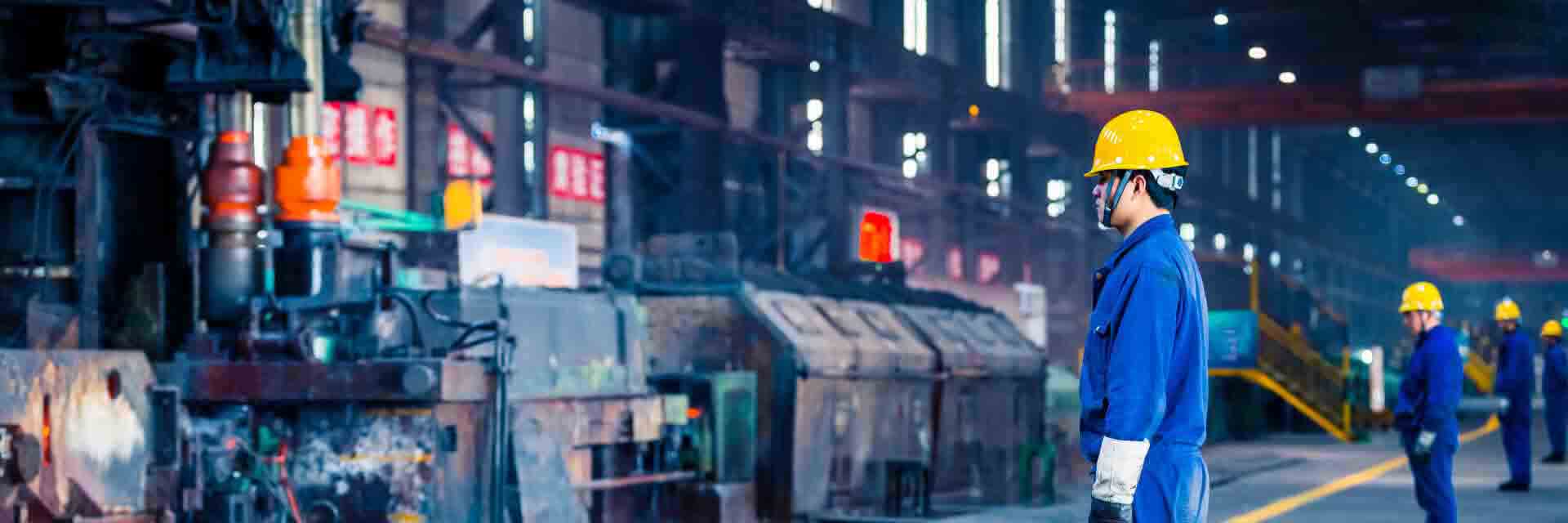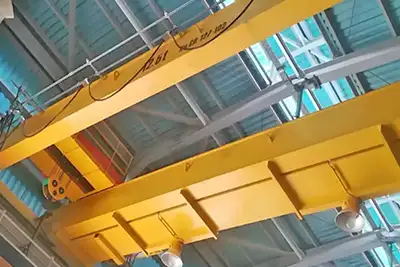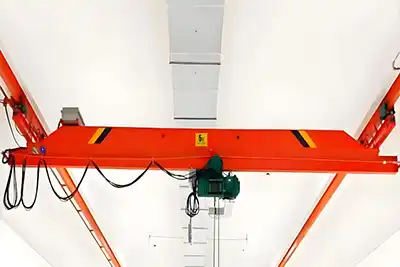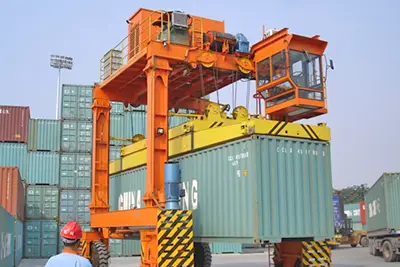Automatic Grab Bucket Cranes: Revolutionizing Bulk Handling Efficiency
Automatic Grab Bucket Cranes enhance material pickup, reduce waste, improve safety, and boost productivity in bulk handling operations.
Introduction: Grab Bucket Automatic Overhead Crane
Warehouse operations are changing fast. As businesses grow and demand for quick deliveries increases, warehouses need better ways to handle materials. Bulk materials, like coal, grains, or ores, are especially tricky. Moving these large amounts quickly and efficiently has always been a challenge. With the rise of e-commerce and faster production timelines, warehouses need systems that can keep up.
Growing Demand for Efficient Bulk Material Handling Systems
- Rising Demands: More products need to be moved in less time. Warehouses are handling more volume and variety than ever before.
- Space and Speed: Limited space and tight schedules mean traditional methods can’t cut it anymore. The need for fast, efficient handling is higher than ever.
- Manual Labor Limitations: Traditional handling methods still rely heavily on manual labor. This approach can be slow and prone to mistakes, especially with large, bulk materials.
Automatic Grab Bucket Cranes as a Solution
So, what’s the answer? Automatic Grab Bucket Cranes are becoming a popular choice. These cranes are designed to handle bulk materials with ease, replacing older systems that just don’t keep up.
- How They Work: These cranes use grab buckets that automatically pick up and move bulk materials. They’re designed to make the process faster and more efficient.
- Why They Matter: With automatic controls, grab bucket cranes reduce the need for manual labor and cut down on errors. This helps keep operations running smoothly and without delays.
- The Future of Warehouse Handling: As more businesses look for ways to boost productivity and reduce costs, these cranes offer a smart, modern solution. They’re not just improving operations today—they’re setting the stage for future growth.
In short, Automatic Grab Bucket Cranes are a big step forward. They’re changing the way warehouses handle bulk materials, making operations faster, safer, and more efficient.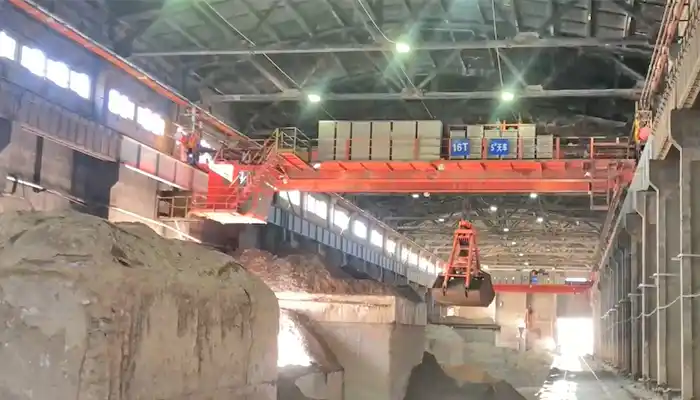
Traditional Challenges in Bulk Material Handling
Handling bulk materials in warehouses has never been easy. The older methods have their limitations, and as demand increases, these challenges become even more apparent. Let’s take a closer look at some of the main problems that traditional bulk material handling systems face.
Space Constraints
- Limited Storage Area: Warehouses often have limited space. As companies deal with larger volumes of materials, they need efficient ways to store and move them. Traditional systems, like conveyor belts and manual labor, take up a lot of space and don’t always maximize warehouse capacity.
- Inefficient Use of Vertical Space: Traditional systems don’t always take advantage of the height in warehouses. With Automatic Grab Bucket Cranes, you can optimize the vertical space, allowing for more efficient use of the overall area.
Labor-Intensive Operations
- Heavy Manual Work: A lot of traditional methods still rely heavily on workers to manually load and unload bulk materials. This is tiring, time-consuming, and prone to human error.
- Safety Risks: The physical nature of the work increases the risk of accidents. Workers might suffer injuries from repetitive tasks or from handling heavy loads without proper equipment.
- Slow Operations: Manual handling is slow. It can cause bottlenecks and delays, especially during peak times. It also reduces the overall productivity of the warehouse.
Inconsistent Pickup Accuracy
- Difficult Material Handling: Bulk materials like grains, coal, or scrap metal are tricky to pick up. Without the right tools, workers can have a hard time grabbing the right amount of material, which can lead to waste and mistakes.
- Human Error: With traditional systems, the chance for errors increases. Workers might grab too much or too little, or miss parts of the load, causing inefficiencies.
Equipment Failures
- Wear and Tear on Equipment: Traditional cranes and lifting systems often involve a lot of moving parts, such as wire ropes, pulleys, and motors. Over time, these parts wear out. Wire ropes, for example, are especially prone to failure after continuous use.
- Maintenance Costs: Equipment breakdowns are expensive. Not only do they lead to costly repairs, but they also cause downtime, which affects the entire operation. Regular maintenance is needed to keep things running smoothly, but it’s not always foolproof.
- Frequent Downtime: Unexpected breakdowns happen, leading to delays in material handling. This can stop the flow of operations and cause significant financial losses.
Safety Risks
- Accidents and Injuries: In traditional systems, where heavy lifting is done manually or with older equipment, accidents are a big concern. Swinging loads or workers in close proximity to moving parts can result in serious injuries.
- Lack of Control: In older systems, there’s often less automation. This means the equipment can’t always respond as quickly or as accurately to changing conditions, which increases the risk of mishandling and accidents.
In short, traditional bulk material handling methods come with a host of challenges—space issues, reliance on manual labor, inconsistent accuracy, frequent equipment breakdowns, and safety concerns. These issues make it harder for warehouses to keep up with the growing demands of modern business. That’s where Automatic Grab Bucket Cranes come in, providing a solution to many of these ongoing problems.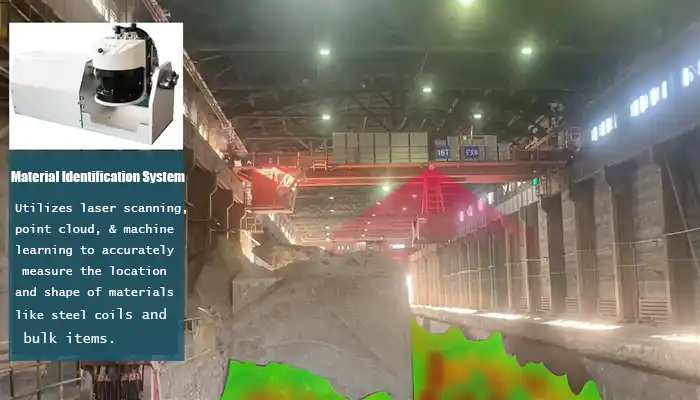
How Pulsed Electromagnetic Scanning Enhances Material Pickup Accuracy
When handling bulk materials, accuracy is key. Traditional methods often struggle with picking up the right amount of material, leading to waste and inefficiency. Pulsed Electromagnetic Scanning is a technology that’s changing the game, offering better control and more precise material handling.
What is Pulsed Electromagnetic Scanning?
- The Technology: Pulsed electromagnetic scanning uses electromagnetic waves to detect and map materials below the surface. This technology sends out pulses that interact with materials and then measures the return signals. The response time and signal strength help determine the type, density, and location of the material.
- How It Works: Think of it like a sonar system, but for materials. By sending electromagnetic pulses into a pile of bulk material, the system detects the exact structure of the material below, whether it’s a lump of coal, grains, or any other bulk item.
Improved Material Detection
- Better Detection of Materials: With electromagnetic scanning, cranes can detect materials that are hidden beneath layers of bulk. This is a huge improvement over older methods, where workers or machines might miss certain areas, leading to incomplete grabs.
- Handling Complex Materials: For bulk materials that vary in size or shape, like metal scrap or gravel, electromagnetic scanning helps the crane get a better understanding of the material composition. This allows it to adjust its grip or pickup method accordingly, reducing errors in material handling.
Increased Precision in Pickup
- Fine-Tuned Control: The precise data provided by electromagnetic scanning allows the crane’s grab bucket to respond more accurately. The system can adjust in real-time, making sure that the bucket grabs exactly what it needs and not too much or too little.
- Improved Bucket Grip: When a crane can “see” what’s inside the pile, it can control the grab bucket’s movements more effectively. This reduces the chances of material slipping out or being left behind. The crane can pick up the right amount every time, ensuring smoother operations.
Minimized Wastage
- Less Material Loss: By accurately detecting the material and grabbing only what’s needed, pulsed electromagnetic scanning significantly reduces material loss. In traditional systems, poor detection and inaccurate grabbing often lead to wastage, where materials spill over or are incorrectly picked up.
- Cost Savings: Less waste means more efficient use of materials, which translates into cost savings. For industries dealing with high-volume bulk materials, this reduction in wastage can add up quickly, helping warehouses and facilities reduce costs while improving their environmental footprint.
In summary, Pulsed Electromagnetic Scanning is a powerful tool that enhances the accuracy and efficiency of material handling. It improves detection, increases precision in grabbing, and minimizes wastage, making bulk material handling faster, more reliable, and cost-effective.
Features That Maximize Full Bucket Rate and Prevent Wire Rope Failures
In bulk material handling, achieving the highest efficiency with minimal losses is essential. Optimized Grab Bucket Design and Wire Rope Durability are key components in maximizing performance and preventing operational issues. Let’s break down these features in more detail.
Optimized Grab Bucket Design
- Shape and Size for Maximum Load: The grab bucket’s shape and size are designed to optimize the amount of material it can hold. A well-designed bucket has a larger opening and an improved closure mechanism, ensuring it can scoop up the most material with minimal spillage.
- Specialized Teeth and Edges: Grab buckets often feature reinforced teeth or edges that help in cutting through the material more effectively. This allows the bucket to hold and pick up even sticky or dense materials, which would otherwise be challenging to lift.
- Efficient Closing Mechanism: The mechanism that closes the bucket plays a huge role in ensuring that no material escapes once it’s grabbed. Features like smooth and fast closing actions reduce the chances of material spilling out while being lifted, maximizing the full bucket rate.
- Minimized Material Loss: By optimizing the bucket's design, the chance of losing material during pickup or transportation is drastically reduced. This means more material is successfully moved per cycle, improving overall productivity.
Enhanced Load Handling Capacity
- Larger Load Capacity: Modern grab buckets are designed to carry larger loads. By improving structural strength and using durable materials, these buckets can handle more material per lift, increasing the efficiency of each cycle.
- Improved Bucket Mechanisms: Bucket mechanisms, like hydraulic or electric actuators, are designed to handle heavier and larger loads. This means that even when the bucket is filled to its maximum capacity, it can be lifted and moved without straining the system.
- Balanced Distribution of Load: Enhanced design also focuses on evenly distributing the material inside the bucket. This prevents the bucket from tilting or becoming unbalanced, which could slow down the lifting process and reduce efficiency.
- Reduced Cycle Time: With better load handling, the crane can complete more material lifts in less time. This directly boosts overall handling speed and warehouse throughput.
Wire Rope Durability
- Strong, Corrosion-Resistant Materials: The durability of wire ropes is critical for preventing failures. Modern wire ropes are made from high-quality, corrosion-resistant materials like galvanized steel, which last longer and can withstand harsh environments.
- Better Coating and Lubrication: Some wire ropes come with specialized coatings or internal lubrication systems that reduce friction and wear. This extends the rope's lifespan and ensures smooth operation, especially in high-stress environments.
- Increased Rope Strength: Advances in rope design, like using multi-strand construction, increase the strength of the wire rope, enabling it to support heavier loads and handle more frequent operations without failure.
- Less Frequent Replacement: By improving rope durability, the need for frequent replacements is reduced. This helps in minimizing downtime and maintenance costs while keeping the crane running efficiently.
Automatic Tension Control
- Real-Time Tension Monitoring: One of the most important features in preventing wire rope failure is automatic tension control. This system continuously monitors the tension in the wire rope during crane operations. It adjusts in real-time to ensure the rope remains at optimal tension, preventing excessive strain that could lead to premature wear or breakage.
- Prevents Overloading: Automatic tension control can detect when the rope is under too much strain (for example, when the bucket is overloaded) and will either stop the operation or reduce the load, ensuring the crane operates safely and efficiently.
- Smooth Lifting Operations: Maintaining the right tension also ensures smoother and more stable lifting. The rope moves without jerking or sudden movements, which not only improves efficiency but also reduces the wear and tear on the crane’s lifting components.
- Prolongs Equipment Life: By continuously monitoring and adjusting the tension, this system helps extend the life of both the wire rope and the crane’s hoisting mechanism. This reduces long-term maintenance costs and ensures that the crane remains in top condition for longer.
In conclusion, Optimized Grab Bucket Design and Automatic Tension Control are essential in ensuring that the crane handles bulk materials efficiently and without failures. With features that increase load handling capacity and protect the wire rope from excessive wear, the crane can perform at its best, reducing downtime, minimizing material loss, and improving the overall efficiency of bulk material handling operations.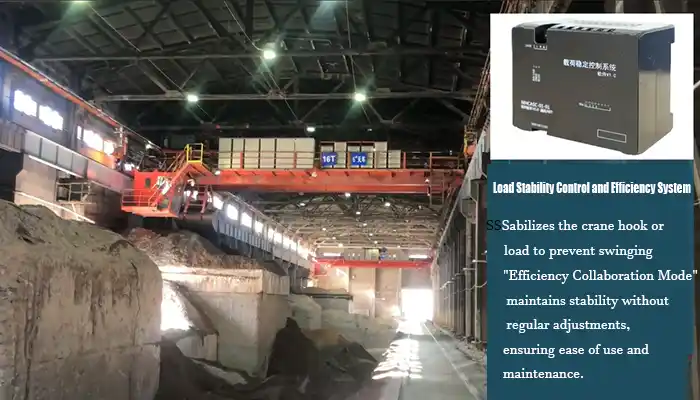
How Anti-Sway Control Systems Improve Safety and Productivity
Anti-sway control systems are a key feature in modern cranes, and they have a huge impact on both safety and productivity. These systems are designed to reduce the swinging or swaying of the crane’s load, which is a common issue in traditional cranes. By minimizing sway, cranes become more stable, safer, and quicker in operation.
What is Anti-Sway Control?
- The Technology: Anti-sway control technology uses sensors and advanced algorithms to monitor and adjust the crane’s movements in real time. The system detects any swinging of the load and automatically corrects the crane’s position to prevent it from swinging further.
- How It Works: The system typically works by adjusting the speed and direction of the crane’s hoisting and trolley motions. When it detects sway, it calculates the necessary adjustments and makes precise corrections to stabilize the load. This is done without the need for manual input, making it fully automated.
- Types of Control: Anti-sway systems can be either passive or active. Passive systems rely on simple mechanical designs to reduce sway, while active systems use electronic control to continuously adjust crane movements for optimal stability.
Safety Benefits
- Reduces Swinging Loads: One of the main dangers in crane operations is swinging loads, especially when transporting heavy or unevenly distributed materials. The swinging of the load can cause accidents, damage to materials or equipment, and even injury to workers. Anti-sway control systems actively reduce this swinging motion, improving safety for everyone involved.
- Prevents Collisions: Swaying loads can lead to collisions with nearby structures, other cranes, or workers on the ground. By stabilizing the load, the anti-sway system helps avoid these types of accidents.
- Improved Stability in Tight Spaces: In crowded or confined warehouse environments, the risk of accidents increases when cranes cannot precisely control their movements. Anti-sway control allows the crane to operate with greater precision in such settings, enhancing both operator and worker safety.
- Lower Injury Risks: By reducing load sway, the risk of accidents like crane tipping or material falling is decreased, leading to a safer work environment overall.
Productivity Boost
- Faster Load Handling: When loads sway, crane operators must slow down and carefully navigate the movement to avoid accidents. Anti-sway control reduces the need for these slow, cautious movements, allowing the crane to operate at a faster pace while maintaining stability.
- Fewer Delays: Reducing sway means the crane can handle loads more smoothly, resulting in fewer interruptions or delays during material handling. This translates into faster cycle times and quicker turnaround for tasks, improving overall productivity in the warehouse or workshop.
- Optimized Movement: Anti-sway control systems also allow the crane to operate at its full potential, optimizing movements and lifting speeds. By eliminating the need for constant manual corrections, operators can focus on other aspects of the operation, further boosting efficiency.
Impact on Workflow
- Smooth and Continuous Operations: Anti-sway control systems help ensure that the crane operates in a smooth, continuous flow. This prevents the disruptions that would normally occur if the load started swinging, allowing the crane to work seamlessly within the overall workflow.
- Less Downtime: With reduced sway, cranes are less likely to experience operational disruptions caused by safety concerns or the need for manual intervention. This leads to reduced downtime and better use of resources.
- Enhanced Coordination: In environments where multiple cranes are operating at once, anti-sway control ensures each crane can perform its tasks without interfering with others. This leads to better coordination between machines and more efficient material handling across the entire warehouse.
- Consistency in Operations: By eliminating unpredictable swaying, the anti-sway system helps maintain consistency in the handling of bulk materials. Cranes are able to follow a predictable path, improving the overall workflow and making it easier to plan tasks.
In conclusion, anti-sway control systems play a critical role in enhancing both safety and productivity in crane operations. They reduce the risks of swinging loads, prevent accidents, and improve the speed and efficiency of material handling. By contributing to smoother, more coordinated crane operations, these systems help streamline workflows and ensure continuous, stable performance.
Intelligent Scheduling Systems for Smarter Warehouse Management
In modern warehouse operations, managing multiple tasks, resources, and equipment simultaneously can be a challenge. Intelligent Scheduling Systems bring smart automation into the mix, streamlining operations and improving overall efficiency. These systems optimize task management, help with resource allocation, and even prevent unplanned downtime, creating a more seamless and responsive operation.
What is an Intelligent Scheduling System?
- The Basics of Smart Scheduling: An Intelligent Scheduling System is a software-driven solution that uses advanced algorithms and real-time data to manage and allocate tasks within a warehouse or distribution center. It integrates data from multiple sources—such as warehouse sensors, crane systems, and labor management tools—to create an optimized schedule for material handling and crane operations.
- Automation at Its Core: The system automatically schedules crane tasks, assigning specific loads or materials to different cranes based on availability, workload, and priorities. It can also adapt to changing conditions and unexpected events, such as delays or equipment failures.
- Key Features: These systems typically include features like task prioritization, real-time updates, and integration with other warehouse management systems (WMS) for a holistic view of warehouse operations.
Real-Time Decision Making
- Dynamic Task Management: One of the biggest advantages of intelligent scheduling is its ability to make real-time decisions based on current conditions. For example, if one crane is unavailable due to a delay or maintenance issue, the system can automatically reassign tasks to other cranes, minimizing downtime.
- Adaptability to Changes: If a shipment is delayed or a new high-priority order comes in, the system adjusts instantly. This real-time adaptability allows for more responsive management, preventing bottlenecks and improving task flow.
- Optimal Task Assignment: By using data from sensors and monitoring systems, the scheduler can determine which crane is best suited for each task, based on factors like weight capacity, speed, and current load. This ensures that each crane is operating at peak efficiency without overloading any one piece of equipment.
Efficient Resource Allocation
- Maximizing Crane Usage: Intelligent scheduling systems optimize the use of available cranes by ensuring that each crane is used to its full potential. It avoids idle time by coordinating crane activities so that each piece of equipment is working on tasks that match its capabilities. If a crane is underutilized, the system will reassign tasks to balance the workload and reduce unnecessary downtime.
- Labor Optimization: These systems also take into account the availability of labor. By automatically assigning crane operators or workers to tasks based on skill levels, location, and task priority, the system helps ensure that labor resources are being used effectively.
- Material Handling Efficiency: Beyond cranes and workers, smart scheduling can also optimize the movement and storage of materials. By analyzing data on product movement and warehouse layout, the system ensures materials are stored and picked in the most efficient order, reducing time spent searching for materials or transporting them unnecessarily.
Predictive Maintenance
- Proactive Monitoring: Predictive maintenance is one of the standout features of intelligent scheduling systems. The system continuously monitors the condition of cranes and other equipment, using sensors and data analytics to track factors like wear and tear, load usage, and performance metrics.
- Early Detection of Issues: If the system detects an issue—such as abnormal wear in the wire ropes or a potential hydraulic failure—it can alert operators or maintenance teams in advance. This proactive approach allows for repairs or adjustments to be scheduled during non-peak hours, preventing unexpected downtime.
- Reduced Unplanned Downtime: By predicting potential failures before they occur, intelligent scheduling helps to reduce the likelihood of equipment breakdowns that could disrupt warehouse operations. This leads to smoother, more consistent performance and fewer costly emergency repairs.
Improved Workflow
- Streamlined Operations: Overall, intelligent scheduling leads to smoother, more efficient workflow management. By automating the scheduling and allocation of tasks, the system ensures that cranes, workers, and materials move seamlessly through the warehouse, without bottlenecks or unnecessary delays.
- Better Coordination Between Teams: With automated task assignment and real-time updates, different teams in the warehouse (e.g., crane operators, maintenance personnel, and material handlers) can work more closely together. Everyone knows what tasks are in progress and can plan accordingly, resulting in a more synchronized operation.
- Faster Turnaround Time: Because the system optimizes task assignments and reduces downtime, the overall speed of operations improves. Materials are handled faster, crane operations are smoother, and tasks are completed on time. This leads to quicker processing and better customer satisfaction.
- Higher Throughput: By managing resources more effectively, intelligent scheduling boosts the warehouse’s throughput, meaning more materials can be handled in less time. This is especially important in high-volume warehouses or facilities with tight delivery deadlines.
In summary, Intelligent Scheduling Systems take warehouse management to the next level. They provide dynamic, real-time decision-making, optimize resource allocation, predict and prevent maintenance issues, and ultimately improve workflow. The result is a more efficient, responsive, and cost-effective warehouse operation—helping businesses keep up with increasing demand while reducing costs and downtime.
Conclusion
Automatic Grab Bucket Cranes have truly revolutionized the way bulk material is handled in warehouses, ports, and factories. With their cutting-edge features and technologies, these cranes not only make operations more efficient but also safer and more reliable.
Key Features Recap
- Pulsed Electromagnetic Scanning has enhanced material pickup accuracy, ensuring that cranes grab precisely what they need, minimizing material loss, and improving handling efficiency.
- Optimized Grab Bucket Design and Enhanced Load Handling Capacity allow for smoother, more effective lifting and transport of bulk materials, reducing downtime and increasing throughput.
- Wire Rope Durability and Automatic Tension Control protect the crane's vital components, extending their lifespan and ensuring smooth, uninterrupted operations.
- Anti-Sway Control Systems improve safety by stabilizing loads, reducing swinging risks, and boosting productivity through faster and more efficient material handling.
- Intelligent Scheduling Systems optimize resource allocation, predict maintenance needs, and enable real-time decision-making, resulting in a more efficient, responsive, and coordinated warehouse operation.
Looking ahead, the future of crane technologies seems brighter than ever. As the demand for faster, safer, and more efficient material handling continues to rise, advanced features like AI-powered automation, predictive analytics, and real-time data integration will play an even bigger role in warehouse operations.
Crane systems will continue to evolve, becoming more autonomous and integrated with broader warehouse management systems. Technologies like machine learning will allow cranes to “learn” and adapt to new materials and tasks more efficiently. Robotic automation could further reduce human intervention, lowering the potential for errors and injuries.
In short, advanced crane technologies will not only optimize material handling but will become an integral part of the entire warehouse ecosystem, driving greater productivity, cost efficiency, and safety. The future of bulk material handling is clearly headed toward smarter, safer, and more sustainable operations, with Automatic Grab Bucket Cranes at the forefront of this transformation.

